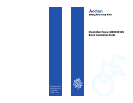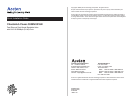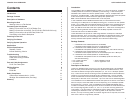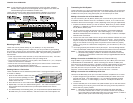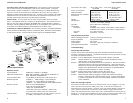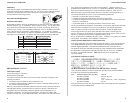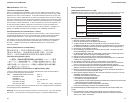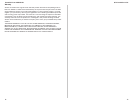
Quick Installation GuideCheetaHub Power-3008N/3016N
4 5
Restrictions on Cascade Length - When cascading to another repeater, note that
the attached repeaters will function as a single logical repeater, with all ports
attached to the same collision domain.
10 Mbps Cascade - Based on the IEEE 802.3 recommendation, you may cascade
up to four 10 Mbps hubs.
100 Mbps Cascade - When cascading to a Fast Ethernet hub, limit the daisy-
chain to two hubs. Another limitation for cascading Fast Ethernet concerns
connection length. All end-node devices (e.g., workstations or servers) must be
within 100 meters (328 feet) of the connected hub; and the overall length between
any two nodes should not exceed 205 meters (672 feet). The easiest way to
cascade two Fast Ethernet hubs is to connect the MDI daisy-chain port on the
front panel to an MDI-X port on the other hub. For example, if both node A and B
are linked to separate repeaters in a two hub system, each using 100 meters of
cable to connect to their respective hub, then the inter-hub cabling will be limited
to 5 meters (16 feet). The only way to extend the inter-hub cabling, would
therefore be to reduce the length of the cabling used to attach the end nodes to
the hubs.
Ethernet Switch - There are no formal restrictions on cascade length if a device is
connected to a switch, which effectively breaks up the collision domain. When a
collision domain is broken up by a device like a switch, cascade length is limited
only by the time-out requirements of the particular applications
running over the network.
Connecting to the Stack’s Backplane
Plug one end of the stacking cable (provided with
this package) into the Out port of the top hub
and the other end into the In port of the next
hub. Repeat this step for each hub in the stack
so that there is a simple chain starting from the
Out port of the top hub and ending at the In
port of the last hub.
You can stack up to six units using the stack ports.
Notes: 1.If more than one hub with internal switching (either the EH3008N-SW or
EH3016N-SW) is placed in the stack, switching between stack segments will
be managed by the highest unit in the stack, and internal switching will be
disabled for all other units.
2.If any hubs in the stack are powered off, traffic flowing across the stacks
backplane will automatically bypass those units.
Powering On the Hub
1. Plug the power cord into the power socket at the rear of the hub, and the other
end into a power outlet.
2. Check the LED marked Power on the front panel to see if it is on. The unit will
automatically select the setting that matches the connected input voltage.
Therefore, no additional adjustments are necessary when connecting it to any
input voltage within the range marked on the rear panel.
Verifying Port Status
Check each connection by viewing the port status indicators shown in the following
figure and table.
DEL etatS noitacidnI
rewoP)neerg(nO.rewopgniviecersibuH
tcA)neerg(gnihsalF.subretaeperM001roM01ehtgnisrevartsiciffarT
loC)wolley(gnihsalF.tnemgesM001roM01ehtnidetcetednoisilloctekcaP
kniL)neerg(nO.noitcennockrowtenM001dilavadehsilbatsesahtroP
)wolley(nO.noitcennockrowtenM01dilavadehsilbatsesahtroP
noititraP)wolley(nO.krowtenehtmorfdenoititrapneebsahtropehT
%litUM01)wolley/neerg(nO.)wolley(%46,)neerg(%23/61/4tanoitazilitutnemgesM01
%litUM001)wolley/neerg(nO.)wolley(%46,)neerg(%23/61/4tanoitazilitutnemgesM001
CNB)wolley(nO.)ylnoWS-N6103HE,N6103HE(.krowtenmorfdenoititraptroP
Verifying System Operation
Verify that all attached devices have a valid connection. The hub monitors the link
status for each port. If any device is properly connected to the hub and transmitting
a link beat signal, the Link indicator will light up for the corresponding port. If the Link
indicator fails to light when you connect a device to the hub, check the following items:
Be sure the twisted-pair cable is properly attached to the connected device and
the hub. Verify that the media connector snaps into place when attached.
See if your cable is functioning properly by using it for another port and attached
device that displays valid indications when connected to the network.
Check the length of each twisted-pair cable to be sure it does not exceed 100
meters (328 feet). If you have cascaded two Fast Ethernet hubs together, be sure
the interhub cabling is no longer than 5 meters (16 feet).
Verify that the workstation's adapter card is functioning properly by trying it in
another computer that has been successfully connected to the network.
Applications
These dual-speed CheetaHubs allow great flexibility in configuring your network.
You can use them in a stand-alone or multiple hub configuration to mix and match
both legacy Ethernet and Fast Ethernet network resources on your local network.
Moreover, you can easily extend your LAN by making a high-speed connection to a
collapsed backbone device (e.g., a switch or a router).
Stand-Alone Network - The CheetaHubs with the internal switching function
(EH3008N-SW, EH3016N-SW) can be used in a simple stand-alone configuration as
illustrated in the figure below. Regardless of whether you are making 10 or 100
Mbps connections with twisted-pair cable, limit the distance for each cable to 100
meters (328 feet).



